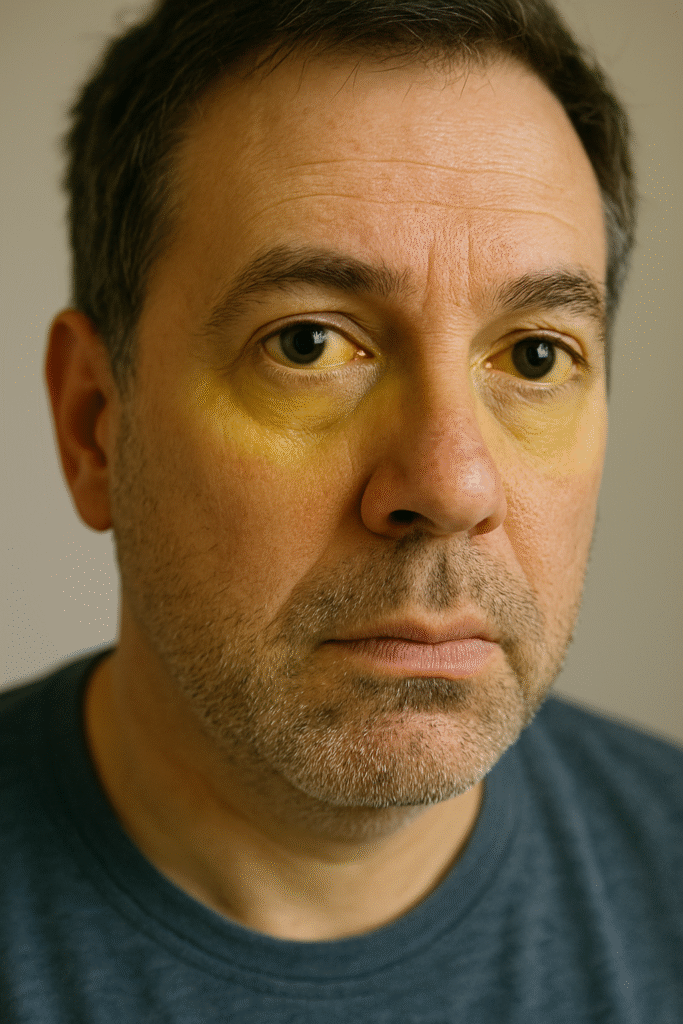What is Jaundice?
Jaundice isn’t a disease itself — it’s a sign that something else is going on inside your body. It shows up as yellowing of the eyes and skin, caused by high levels of bilirubin, a yellow-orange pigment in the blood.
Bilirubin is produced when red blood cells break down. Normally, your liver processes it, and it gets removed from your body through stool. But if something interferes with this process — too much bilirubin is made, the liver can’t handle it, or there’s a blockage — bilirubin builds up, and that’s when jaundice sets in.
It’s quite common in newborns (affecting about 60% of full-term babies in the first week), but in adults, it usually points to liver or bile duct problems.
How Does Jaundice Happen?
Let’s imagine your body as a city and the liver as the waste treatment plant. Red blood cells are like delivery trucks — after a long journey, they retire. When they break down, they leave behind bilirubin, like leftover packaging. The liver collects it, breaks it down, and sends it away through the intestines.
But if:
- Too many trucks are retiring at once (more red blood cell breakdown),
- The treatment plant is broken (liver disease),
- Or the exit pipes are blocked (bile duct obstruction),
…then bilirubin piles up in the bloodstream — and the skin starts to turn yellow.
What Causes Jaundice?
There are three main categories of causes. Think of them as problems happening before, within, or after the liver:
1. Pre-hepatic (Before the Liver)
This is when too much bilirubin is made because red blood cells are breaking down rapidly.
Common causes include:
- Hemolytic anemia (body destroys red blood cells too early)
- Malaria
- Sickle cell disease
- Certain medications or autoimmune diseases
2. Hepatic (Inside the Liver)
The liver itself is damaged or inflamed, so it can’t process bilirubin properly.
Common causes:
- Hepatitis (viral or alcoholic)
- Liver cirrhosis
- Liver cancer or metastasis
- Genetic disorders (like Gilbert’s syndrome)
3. Post-hepatic (After the Liver)
This is due to a blockage in the bile ducts, preventing bilirubin from leaving the body.
Common causes:
- Gallstones
- Pancreatic cancer
- Bile duct strictures or tumors
Risk Factors
Anyone can get jaundice, but some people are more at risk than others.
- Newborns – especially premature babies or those with blood type incompatibility.
- People with chronic liver conditions – such as hepatitis B or C, or fatty liver disease.
- Heavy alcohol consumers
- Individuals with gallbladder issues
- Those with certain inherited disorders – like Gilbert’s syndrome or Crigler-Najjar syndrome
If you’re often tired, losing weight unexpectedly, or notice yellowing of your eyes — it’s worth getting checked out.
Other Symptoms that May Appear
Jaundice rarely comes alone. Here’s what might tag along depending on the cause:
- Dark urine – bilirubin spills into urine, making it tea-coloured
- Pale stool – less bilirubin reaching the intestines
- Itchy skin – bile salts can build up under the skin
- Fatigue or abdominal pain
- Nausea, vomiting, and weight loss
- In severe liver disease: swelling of legs/abdomen and mental confusion
The deeper the yellow, the more urgent the situation might be.
How Is Jaundice Diagnosed?
The gold standard test for jaundice isn’t just looking at the eyes. Doctors will usually start with:
- Liver Function Tests (LFTs): Measures levels of bilirubin, liver enzymes (ALT, AST), and alkaline phosphatase.
- Complete Blood Count (CBC): To check for signs of anemia or infection.
- Ultrasound: Helps spot blockages in the bile duct or gallbladder.
- CT or MRI scans: For more detailed views of the liver and surrounding organs.
- Liver biopsy: In chronic cases, to understand the extent of liver damage.
Doctors use a mix of these tools to pinpoint whether the problem is before, within, or after the liver.
Treatment for Jaundice
Treating jaundice means treating its cause. There’s no “one pill fixes all” approach.
Depend on causes:
- If caused by viral hepatitis: supportive care, rest, hydration, and antiviral drugs if needed.
- If due to bile duct obstruction (e.g., gallstones): procedures like ERCP (Endoscopic Retrograde Cholangiopancreatography) or surgery to remove the block.
Other options:
- Blood transfusions in hemolytic anemia
- Corticosteroids or immunosuppressants for autoimmune conditions
- Phototherapy for newborn jaundice — blue light helps break down bilirubin
- Lifestyle changes: Avoid alcohol, maintain a healthy weight, and manage medications carefully
Sometimes, in end-stage liver disease, a liver transplant might be the only option.
Final Thoughts
Jaundice might seem like just yellow skin — but it’s your body waving a big, colourful warning flag. It often tells you that your liver or gallbladder needs help.
Don’t ignore the signs. If your eyes look yellow, your pee is darker than usual, or your energy levels are way off — it’s time to get checked. The earlier jaundice is caught and treated, the better your outcomes.
References
- “Jaundice: Symptoms, Causes, Diagnosis, and Treatment” – Cleveland Clinic, 2024. https://my.clevelandclinic.org/health/diseases/14812-jaundice
- “Jaundice in Adults” – American Liver Foundation, 2023. https://liverfoundation.org/jaundice-in-adults/
- “Jaundice in Newborns” – Mayo Clinic, 2023. https://www.mayoclinic.org/diseases-conditions/newborn-jaundice
- “Bilirubin Metabolism and Jaundice” – Medscape, 2023. https://emedicine.medscape.com/article/179469-overview

